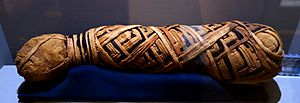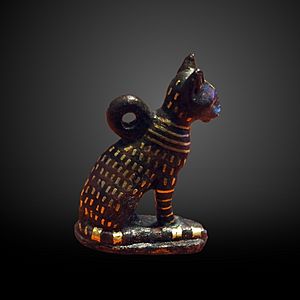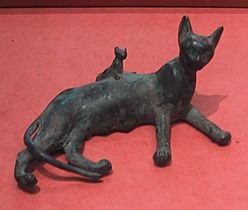Cats in ancient Egypt facts for kids

For over 3,000 years, cats were very important in the daily life and religious practices of ancient Egypt. Many ancient Egyptian gods and goddesses were shown with cat-like heads. These included Mafdet, Bastet and Sekhmet. They represented things like justice, new life, and power. The goddess Mut was also sometimes shown as a cat or with a cat.
Ancient Egyptians loved cats because they hunted venomous snakes and protected the Pharaoh. This was true from at least the First Dynasty of Egypt. We know this because cat skeletons have been found in tombs from the 12th Dynasty. The Book of the Dead even says that a cat represents Ra, the sun god, showing how important they were for life on Earth. Cat decorations from the New Kingdom of Egypt show that the cat cult became very popular in everyday life. Cats were often linked to the goddess Bastet.
Huge cat cemeteries have been found at places like Speos Artemidos, Bubastis and Saqqara. These cemeteries were used for hundreds of years. They contained countless mummified cats and cat statues. Many of these are now in museums all over the world. At Gizeh, the African wildcat (Felis lybica) was the most common cat found, followed by the jungle cat (Felis chaus). Because so many cat mummies were found, it shows that the cat cult was a big part of Egypt's economy. It meant people had to breed cats and trade for food, oils, and resins to embalm them.
Contents
Cats in Ancient Egypt: A Timeline
Early Cat Gods and Protectors
Mafdet was the first known cat-headed god in ancient Egypt. During the First Dynasty, she was seen as a protector of the pharaoh's rooms. She guarded against snakes, scorpions, and evil. She was sometimes shown with the head of a leopard or a cheetah. She was especially important during the time of Pharaoh Den.
The goddess Bastet became known from at least the Second Dynasty. Back then, she was shown with a lion's head. Seals and stone pots with her name were found in the tombs of pharaohs Khafre and Nyuserre Ini. This shows she was seen as a protector from about 3000 BC. A wall painting from the Fifth Dynasty at Saqqara shows a small cat with a collar. This suggests that tamed African wildcats were kept as pets by the pharaohs around 2600 BC.
Cat-headed amulets became popular around 2100 BC, during the 11th Dynasty. A painting from this time in the tomb of Baqet III shows a cat hunting a rat-like animal.
A tomb at Umm El Qa'ab held 17 cat skeletons from around 2000 BC. Small pots next to them might have held milk for the cats. Many tomb paintings in the Theban Necropolis show cats in family scenes. These tombs belonged to important people from the 18th Dynasty (around 1500-1400 BC). The paintings show cats sitting under chairs during meals, eating meat or fish. Some even show cats with geese or monkeys. Cats were also often shown in hunting and fowling scenes in these tombs.
The first known mummified cat was found in a fancy limestone sarcophagus from about 1350 BC. People believe this cat was the beloved pet of Prince Thutmose.
Cats as Sacred Animals
From about 950 BC, during the 22nd Dynasty, the goddess Bastet and her temple in Bubastis became even more popular. She was now shown only with a small cat head. Domestic cats (Felis catus) were increasingly seen as sacred and worshipped. When they died, they were embalmed, put in coffins, and buried in cat cemeteries. The domestic cat was seen as a living form of Bastet, protecting homes from animals that ate grain. The lion-headed goddess Sekhmet protected the pharaohs.
During the rule of Pharaoh Osorkon II in the 9th century BC, Bastet's temple was made bigger. Cat statues from this time came in many sizes and materials, like bronze, alabaster, and faïence.
Mummifying animals became very popular during the Late Period of ancient Egypt (from 664 BC). Mummies were used as votive offerings to the gods, especially during festivals or by pilgrims. Old underground tombs from the New Kingdom were reused as cemeteries for mummies given to Bastet.
Around 450 BC, the historian Herodotus wrote that the yearly festival at the Bubastis temple was the biggest in Egypt. Hundreds of thousands of pilgrims attended it.
During the Hellenistic period (323 to 30 BC), the goddess Isis became linked to Bastet and cats. An inscription at the Temple of Edfu says, "Isis is the soul of Bastet." In this period, cats were even bred just to be mummified and offered to the gods.
Diodorus Siculus wrote that killing a cat was a very serious crime.
The Decline of Cat Worship
After Egypt became a Roman province in 30 BC, the special link between cats and religion slowly faded. Roman emperors issued laws in the 4th and 5th centuries AD that gradually stopped the practice of paganism (worshipping many gods) in Egypt. Pagan temples were taken over, and sacrifices were forbidden. By 415 AD, the Christian church received all property that used to belong to pagan worship.
Even after this, cats were still respected. In the 15th century, a traveler named Arnold von Harff saw mamluk warriors in Egypt treating cats with kindness. Gentle treatment of cats is also an important part of Islamic tradition.
Discovering Ancient Cats: Expeditions and Finds
In 1799, French explorers found mummified cats and other animal remains near the old city of Lycopolis. They also found mummified cats and skeletons in the Theban Necropolis. By the 1820s, the Louvre Museum was showing cat statues made of wood, bronze, and pottery, mostly from Bubastis.
In 1830, Christian Gottfried Ehrenberg described three types of small cats in Egypt: the jungle cat, the African wildcat, and a "sacred cat" that was between the size of a jungle cat and a domestic cat. He called this cat Felis bubastis.
The Egypt Exploration Society funded digs in Bubastis in the late 1880s. Édouard Naville reported that many cat statues were already being sold in Cairo shops. At the city's cat cemetery, he and his team found huge pits filled with cat and Egyptian mongoose bones. They also found embalming materials, porcelain, bronze items, beads, ornaments, and statues of Bastet. By 1889, the cemetery was thought to be empty.

In the late 1880s, over 200,000 mummified animals, mostly cats, were found at the Beni Hasan cemetery in central Egypt. In 1890, William Martin Conway wrote about the excavations there. He described how local children would sell the mummies they found to travelers.
In 1890, thousands of animal mummies, mostly cats, arrived in Liverpool. A large part was sold as fertilizer, but a small part went to the city's university museum.
The Museum of Fine Arts of Lyon received hundreds of cat mummies found by Gaston Maspero at Beni Hasan, Saqqara, and Thebes. These cats were of all ages, from adults to kittens with baby teeth. Some were inside statues and sarcophagi. The larger ones were wrapped in colorful cloths with decorated heads and ears.
In 1901, Pierre Jouguet found a tomb full of cat mummies near Faiyum. It was located among tombs with crocodile mummies.
In 1907, the British Museum received 192 mummified cats and 11 small carnivores found by Flinders Petrie at Gizeh. These mummies likely date from 600 to 200 BC. Two of these cat mummies were X-rayed in 1980. The X-rays showed that the cats were killed when they were very young, likely to meet the demand for mummified cats as offerings.
In the early 1980s, remains of 23 cats were found in a small tomb at Balat in Dakhla Oasis. This tomb was built around 2500 BC and reused later. The cats were probably mummified because tissue was still stuck to their bones.
Excavations in the Bubasteum area at Saqqara in the early 1980s uncovered 200 cat mummies in the tomb of the Vizier Aperel. In the 1990s, another 184 cat mummies were found in a different part of this tomb. X-rays showed that most were young cats. Many had broken skulls and dislocated spines, suggesting they were beaten to death. In 1996, the tomb of Tutankhamun's wet nurse Maia was found here, containing cat mummies next to human mummies.
In 2001, the skeleton of a male lion was found in Maia's tomb. It also showed signs of mummification. It was about nine years old and likely lived in captivity. It probably died during the Ptolemaic Kingdom period. More recently, in 2009, mummified remains of 335 domestic cats and 29 jungle cats were found in the catacombs of Anubis at Saqqara.
A Famous Legend
In the 2nd century, Polyaenus told a story about a clever plan used by the Persian king Cambyses II during the Battle of Pelusium (525 BC). Cambyses II supposedly placed cats and other animals that Egyptians worshipped in front of his army. The Egyptians reportedly stopped fighting, and the Persians then took over Pelusium.
Gallery
-
Case for an animal mummy topped with a cat; Metropolitan Museum of Art
-
Cat statue of Bastet in the Louvre
-
Sarcophagus for a cat mummy, around 305 BC; Brooklyn Museum
-
Mummified cats in the Natural History Museum, London
-
Late Egyptian bronze statue of a mother cat nursing her kittens, from around 664 – 332 BC, Eskenazi Museum of Art
-
The Gayer-Anderson cat; British Museum
See also
 In Spanish: Gatos en el Antiguo Egipto para niños
In Spanish: Gatos en el Antiguo Egipto para niños
- Islam and cats
- Cultural depictions of cats
- Animal worship













